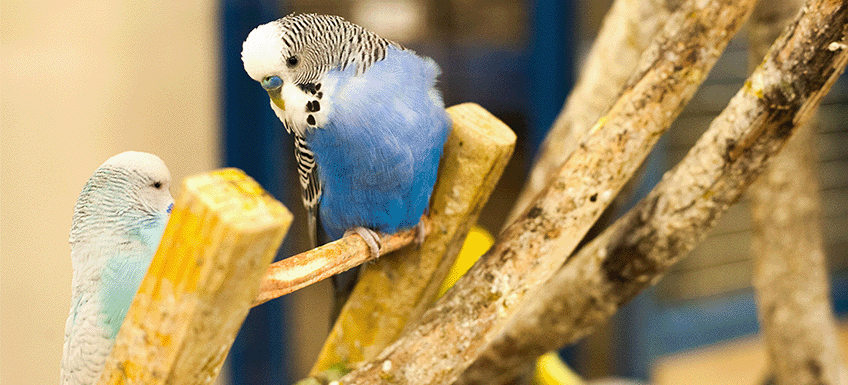
How to Help Your Bird Get More Exercise
Health and Wellbeing
Care
Bird
15/05/2023
Exercise is a crucial part of any birds routine. Not only can it stop them from becoming overweight, it also prevents boredom and make for a happier and healthier bird! Whether it is in the form of walking, climbing, wing flapping or playing games. There are many ways that you can create excitement in your pet birds life all while keeping them fit and active.
In the wild, parrots and other birds fly many kms per day, they have to forage for food, and participate in countless other survival based activities that are all forms of exercise that help to keep them fit. Although pet birds often do not get all these opportunities to exercise. As some pet birds may have clipped wings so they cannot fly or may only have the space to fly short distances. So it is important to consider other safe ways to help your bird get the exercise they need.
Get them climbing
A great way to encourage your pet bird to exercise is to draw on their natural climbing instinct. If you place your pet bird at the bottom of a cage they will naturally climb up to the top of the cage. As for a bird being at the top of a cage or in the wild a tree is the safest place so that they can survey their surroundings. So it is good to incorporate ladders and cargo nets in your birds cage and play areas. Ladders are available for all sizes of birds, from small birds like canaries to large parrots like macaws. You can also incorporate climbing nets or rope cargo nets either in their cage or in their play areas outside the cage.
Let your pet bird forage for its food.
In the wild a lot of a birds exercise comes from foraging to find its food. So this is a good way to motivate your bird to get more exercise. Some simple ways that you can get your bird to forage is to hide some of their favourite treats like sunflower seeds or dried fruit in paper bags and twisted the ends closed. Another good way to draw on your birds foraging instincts is to put pellets or seeds in a shallow bowl filled with clean pebbles, shredded paper or bedding, and place it on the bottom of the cage for your bird to forage through to find the food. This makes them work for their food and actually use their brain to sift through the bowl and find the food. But be sure to select appropriately sized bird safe materials to keep this activity fun and safe for your bird. There are also a range of foraging toys available for birds that can be easily stuffed and refilled with food and placed into their cage.
Provide them with a variety of perches
All pet birds require perches to stand on, but when selecting perches it is important that you use perches made of a wide variety of materials, textures and thicknesses, to give the bird’s toes a rest. The best perches to select for your birds cage are the ones that look the most like those from nature. But it does vary from species to species, as it is important to select perches that are thick enough that your bird’s toes don’t overlap while standing. Smooth wooden dowels also should be avoided, because the smoothness is uncomfortable and hard on the feet in the long term.
Put a new toy in your pet bird’s cage
A good way to get your bird moving is to put a new toy in their cage. Bird toys are made of a range of different materials and colours to entice birds to explore and use their beaks. Bird safe toys can be made of a range of materials from wood, paper, leather or plastic/acrylic. There is also a range of toys on the market, from toys that are made to be chewed destroyed or shredded up that draw on a birds natural destructive tendencies. To interactive toys that encourages birds to talk, forage or preen. A good thing to keep in mind is the toy does not necessarily need to a be new. If you have a few toys they can be swapped out regularly to keep them fresh and exciting for your bird.
Let them fly!
If your bird has full flight it is important that your provide them with a safe area to stretch their wings. When selecting a location pick somewhere large enough for them to flap their wings, with plenty of safe landing spots. Unfortunately a birds cage almost never provides room to fly and even most outdoor aviaries are inadequate to provide proper flying space. However through letting your birds out in your hallway or living room, they have space to stretch its wings and exercise. The parrot does not need to be flying all day long to get exercise but to make up for all the time on its legs in the cage, getting out to fly daily is important for their health.
Encourage them to flap their wings
Although if your pets wings are clipped or trimmed, this does not mean that they do not need to exercise their wings. This is why you will often see your bird tightly gripped onto its perch flapping its wings frantically. This is how caged or clipped birds use and strengthen their wing muscles. A good way to encourage your birds to exercise their wings more is to hold onto their feet securely and encourage it to flap their wings. It may not happen the first time, but it can be trained easily, by putting a command to the action and rewarding them when they do it. This is extremely helpful especially for owners of clipped birds as it allows you to help your bird get the exercise they need.
Let their instincts come out
In the wild birds spend a lot of time shredding branches, so it is important to provide them with natural perches for them to strip the bark off. But be sure to check that the wood is safe for the bird before adding it to their cage, a couple of examples of bird safe trees includes eucalyptus, willow or fruit wood branches (except cherry). This is an easy and affordable way to help your bird to stay active both physically and mentally.
More walking
Another way to give your unflighted or clipped bird more exercise is to encourage it to walk. There are many ways to do this the simplest being, placing your bird on one side of a room or hallway and going to the other side and calling them to use. You can use their favourite treats to entice them to you. But if your bird is hand reared and very bonded to you, you may not even need the food to entice them over. More walking time is a great substitute for birds that are unable to fly, and an easy way to help them to get the exercise they need.
Trick training
A great way to help your bird become more active is to get involved with trick training your pet. Not only can learning tricks provide lots of exercise for your pet, but it can help prevent boredom in birds and offer a wonderful bonding experience as well. There are many tricks that you can teach your bird, from the simple step up, to ‘show us your wings’ or spins. It is easy to teach birds as they are very intelligent and can be easily lured with the use of treats or their favourite foods.

Written by The Pet.co.nz
Team
Written by The Pet.co.nz Team
A team of specialists with backgrounds in animal nursing, animal care, and all things pet related.